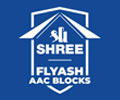Shree Flyash is a product line offered by Shree Cement Limited. It is manufactured at India’s most advanced Flyash Autoclaved Aerated Concrete (AAC) blocks manufacturing unit, powered by cutting-edge German technology from Wehrhahn Gmbh. This state-of-the-art facility operates as a fully automated plant, adhering to precise manufacturing practices to ensure unmatched product quality.
As a market leader, our plant sets new benchmarks in cost-effectiveness and energy-saving management. We achieve this by utilising energy-saving motors, electric energy-saving systems, and heat and steam recovery systems. By incorporating these innovative technologies, we prioritise sustainability and environmental responsibility in our production process. The integration of intelligent machine settings and continuous recording of production and process data enables us to manufacture Flyash AAC blocks with the utmost efficiency. Here we share some of the useful insights on Shree Flyash AAC blocks manufacturing units
Flyash AAC block making process at Shree AAC manufacturing units
1.History:
We established our first manufacturing plant in Bulandshahar, Uttar Pradesh, with an annual installed capacity of 360,000 cubic metres. Our second manufacturing plant, situated in Hapur, Uttar Pradesh, has an annual capacity of 220,000 cubic metres. These state-of-the-art facilities prioritise productivity, flexibility, and sustainability. With zero system waste, precise cutting techniques, low energy consumption, and minimal raw material usage, our plants ensure optimal performance and efficiency.
2. Material preparation, dosing and mixing:
Raw Material Preparation: The raw materials, including sand or pulverised fuel ash, cement, anhydrite (gypsum), lime, water, and a small quantity of aluminium powder, are mixed to create the AAC mixture.
Dosing And Mixing System: The fully automated dosing and mixing plant ensures accurate dosing, weighing, and mixing of all raw materials. The resulting mixture is poured into moulds, where it rises due to chemical reactions, similar to a cake baking.
3.Cutting
Once the cake of AAC has achieved the required strength, it is carefully extracted from the mould. To ensure precise accuracy, wires and knives are used to cut the cake into blocks or panels. Before undergoing the autoclaving process, hand holds, tongue and groove features are meticulously cut into the cake. This step is essential to prevent the need for milling or excessive cutting into the hardened material after autoclaving. By incorporating these measures, the final Flyash AAC blocks or panels maintain their structural integrity and dimensional accuracy, ready to be utilised in construction projects.
4. Curing or autoclaving
Following the cutting process, the Flyash AAC blocks undergo a crucial step known as autoclaving. During autoclaving, the AAC is exposed to a saturated steam atmosphere at a temperature range of approximately 180-190°C. This steam curing is the key factor in creating the distinctive crystalline structure that sets AAC apart from other non-steam cured building materials. The steam curing process enhances the properties of AAC, giving it excellent qualities such as strength, durability, thermal insulation, and fire resistance. This unique structure and the resulting attributes make AAC a superior choice for construction applications.
5. Sorting and packing:
After the autoclaving process, the Flyash AAC blocks or panels undergo sorting and packing, making them ready for dispatch to the construction site.
Looking for AAC blocks for your construction project?
Explore Shree AAC Blocks. Our Flyash AAC blocks provide excellent thermal insulation, maintaining comfortable interiors throughout the year and reducing air conditioning costs significantly. Also, they offer superior strength and durability. The blocks guarantee exceptional acoustic insulation, creating noise-free living spaces. As an earthquake-resistant and fire resistant option, they provide added safety.
The cost-effectiveness of our Flyash AAC blocks is evident because of their lightweight nature – they require fewer joints and materials for construction, and are easy to transport and work with. The lightweight nature of Flyash AAC blocks, helps reduce the quantum of Iron rods and mortar required in the foundations of the building as compared to Red bricks, giving huge savings. Furthermore, these blocks are termite and pest-resistant due to their inert and inorganic composition. Their construction requires 70% less water usage and offers faster construction timelines, significantly reducing labour costs.

